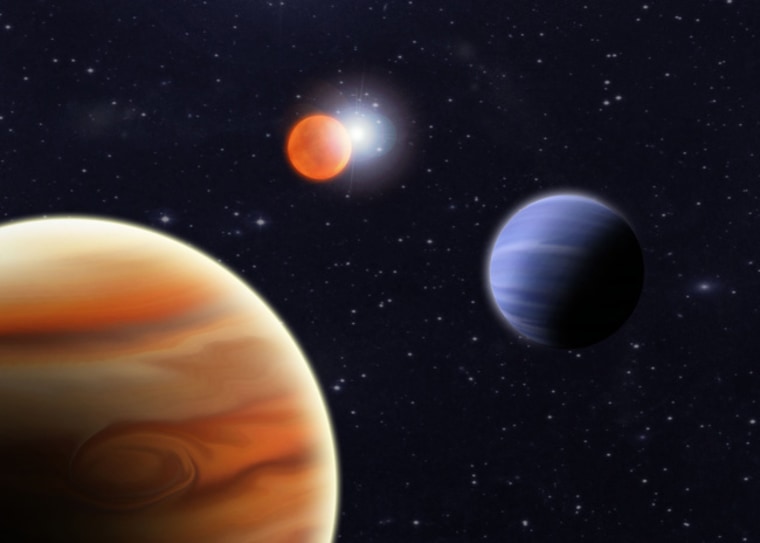Two massive Jupiter-like planets were recently discovered orbiting around two extremely close sister stars an unexpected find, given the disturbing gravitational effects within most binary star systems that usually disrupt planets from forming.
The alien planets were found to orbit around the binary star system NN Serpentis, which is located about 1,670 light-years from Earth.
The more massive of the two stars is a very small white dwarf the burnt-out remnant that is left over when a sun-like star dies. The star is 2.3 times the diameter of Earth, but has a temperature of more than 89,500 degrees Fahrenheit (49,700 degrees Celsius) almost nine times hotter than the surface of the sun.
The other star in the pair is a larger but cooler star, with a mass only one-tenth that of the sun. The two stars are joined in a very tight mutual orbit.
Lucky break
The astronomers caught a lucky break in observing this binary star system because it happens to lie in the same plane as Earth, creating an eclipse every 3 hours and 7 minutes when the larger star moves in front of the smaller one. [ Gallery: The Strangest Alien Planets.]
The resulting change in the brightness of the system acts like a highly precise clock. By monitoring the eclipses, the team of astronomers was able to detect small changes in the timing caused by the gravitational pull of two planets orbiting the stellar pair and tugging them out of whack, altering the eclipse schedule.
The larger planet in the system is about 5.9 times more massive than Jupiter. It orbits the binary stars every 15.5 Earth years at a staggering distance of roughly 558 million miles. Closer in, the second planet orbits every the binary pair every 7.75 Earth years, and is about 1.6 times more massive than Jupiter.
An international team of astronomers detected the planetary system using a wide variety of observations taken over two decades from several ground-based telescopes.
Binary parents
While the discovery of planets outside our solar system is becoming more common, only a tiny fraction of these planets have been found to orbit stars which themselves are in binary or multiple systems. This is simply because in these systems, there is little room between the stars for planets to form.
The two planets in NN Serpentis do not orbit very close to the binary stars, but the double star system was not always as tight as it is now. Back when the present white dwarf star was a normal star, twice as massive as the sun, the two stars were separated by a much greater distance such that the observable eclipses would have happened about once every two years.
When the more massive star ended its normal life of burning hydrogen in its core, it bloated itself into a red giant star and engulfed the second star in its diffuse outer envelope. The friction of the companion star moving within the red giant's envelope eventually caused the red giant to lose 75 percent of its mass.
This left only the intensely hot core of the original star, and a relatively unscathed companion star that now orbits extremely close to the newly created white dwarf.
The turbulent change from a normal double star system to a tight binary containing a hot white dwarf would have been even more dramatic for any planets present beforehand: The 75 percent loss of the original star's mass would also equal a 75 percent loss in the star's gravitational force.
This could easily result in the release of planets, sending them careening off into space. Or, it may simply have resulted in a dramatic change in the planets' orbits.
Second option
In a separate scenario, the planets around NN Serpentis could have also been created only a million years ago, when large amounts of gas and dust were cast off from the main star to form a more massive version of a proto-planetary disk. From this material, planets might have formed. If this is the case, then it is possible that these massive planets were, in fact, born after the death of the star that enabled their creation.
The results of the study are published online in recent issue of the journal Astronomy & Astrophysics.
In a separate discovery, a Jupiter-sized alien planet was recently found orbiting the star HR 7162, which is a binary star system located 49 light-years away, in the constellation Lyra. These recent findings are forcing astronomers to rethink their theories about how gas giant planets form.
